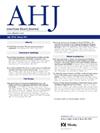Accurate Fick cardiac output estimation: direct and simultaneous oxygen consumption measurement is imperative in heart failure
IF 3.5
2区 医学
Q1 CARDIAC & CARDIOVASCULAR SYSTEMS
引用次数: 0
Abstract
Background
Estimated oxygen consumption (VO2) values may compromise the accuracy of the Fick method for predicting cardiac output (CO) during a right heart catheterization (RHC). We aimed to compare VO2 measured in the hemodynamic laboratory (HL) with those measured on the ward or estimated, and to compare derived CO values with that obtained by thermodilution (TD) in people with severe heart failure (HF).
Methods and Results
In this prospective observational study, VO2 was measured breath-by-breath in the HL and in the ward (within 24h of RHC), or estimated using formulas. CO was calculated from both estimated and measured VO2 and assessed by TD. Eighty individuals with HF (69.6 ± 8.3 years; 74% male) were included. Significant differences were found between HL-measured VO2 (247 ± 55 mL/min), ward-measured VO2 (267 ± 74 mL/min), and the estimated values (Bergstra: 287 ± 33; Dehmer: 234 ± 24; LaFarge: 163 ± 11 mL/min). CO calculated from HL-measured VO2 (5.03 ± 1.51 L/min) differed from CO based on ward-measured VO2 (5.46 ± 1.93 L/min), estimated VO2 (Bergstra: 5.85 ± 1.38; Dehmer: 4.77 ± 1.12; LaFarge: 3.34 ± 0.80 L/min), and by TD (3.65 ± 1.22 L/min). Measured and estimated VO2 values showed moderate association (r values range: 0.479-0.526). CO calculated from HL-measured VO2 showed higher association (r values range: 0.708-0.765) with CO calculated from ward-measured VO2 and estimated VO2. The agreement between HL and ward-measured VO2 was moderate, with a concordance correlation coefficient of 0.48 (0.31;0.62).
Conclusions
In people with severe HF undergoing RHC, VO2 must be directly measured in the HL, rather than on the ward or estimated.
准确的菲克心输出量估计:直接和同时的耗氧量测量是必要的心力衰竭。
背景:估计的耗氧量(VO2)值可能会影响右心导管(RHC)期间预测心输出量(CO)的Fick方法的准确性。我们的目的是比较血液动力学实验室(HL)测量的VO2与病房测量或估计的VO2,并比较重度心力衰竭(HF)患者的CO值与热稀释(TD)获得的CO值。方法和结果:在这项前瞻性观察性研究中,在HL和病房(RHC 24小时内)逐呼吸测量VO2,或使用公式估算。CO由估算和测量的VO2计算,并由TD评估。HF 80例(69.6±8.3岁);男性占74%)。hl测量的VO2(247±55 mL/min), ward测量的VO2(267±74 mL/min)与预测值(Bergstra: 287±33;德:234±24;LaFarge: 163±11ml /min)。根据hl测量的VO2计算的CO(5.03±1.51 L/min)不同于基于ard测量的VO2计算的CO(5.46±1.93 L/min),估计的VO2 (Bergstra: 5.85±1.38;德:4.77±1.12;LaFarge: 3.34±0.80 L/min), TD(3.65±1.22 L/min)。测量值和估计值显示中度相关性(r值范围:0.479-0.526)。从hl测量的VO2计算的CO与从ward测量的VO2和估计的VO2计算的CO具有较高的相关性(r值范围为0.708-0.765)。HL与测得VO2的一致性中等,一致性相关系数为0.48[0.31;0.62]。结论:在接受RHC的严重HF患者中,必须直接在HL中测量VO2,而不是在病房或估计。
本文章由计算机程序翻译,如有差异,请以英文原文为准。
求助全文
约1分钟内获得全文
求助全文
来源期刊

American heart journal
医学-心血管系统
CiteScore
8.20
自引率
2.10%
发文量
214
审稿时长
38 days
期刊介绍:
The American Heart Journal will consider for publication suitable articles on topics pertaining to the broad discipline of cardiovascular disease. Our goal is to provide the reader primary investigation, scholarly review, and opinion concerning the practice of cardiovascular medicine. We especially encourage submission of 3 types of reports that are not frequently seen in cardiovascular journals: negative clinical studies, reports on study designs, and studies involving the organization of medical care. The Journal does not accept individual case reports or original articles involving bench laboratory or animal research.
 求助内容:
求助内容: 应助结果提醒方式:
应助结果提醒方式:


